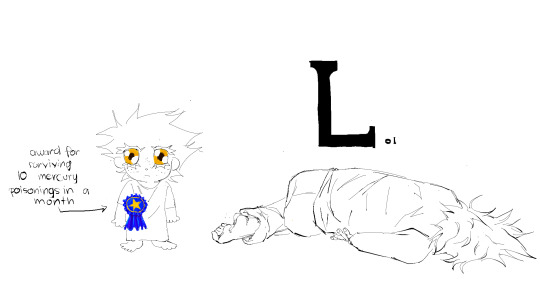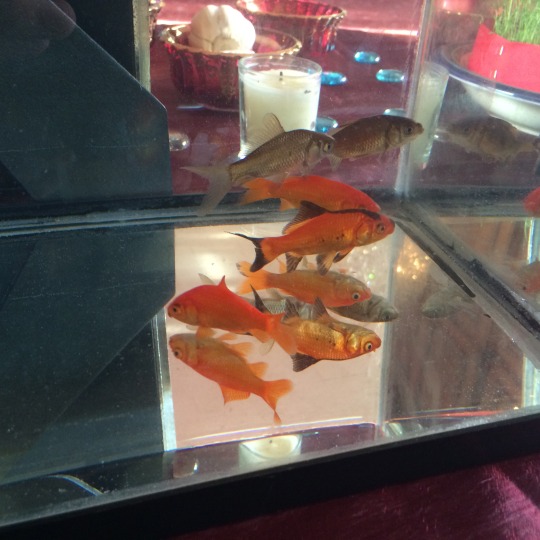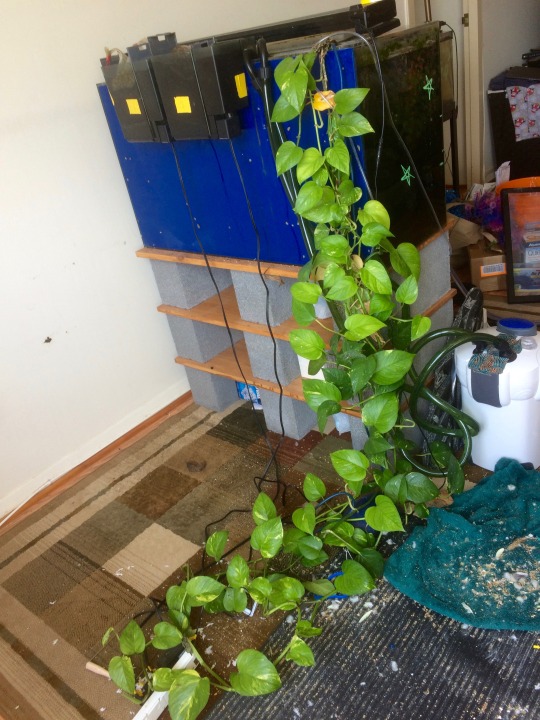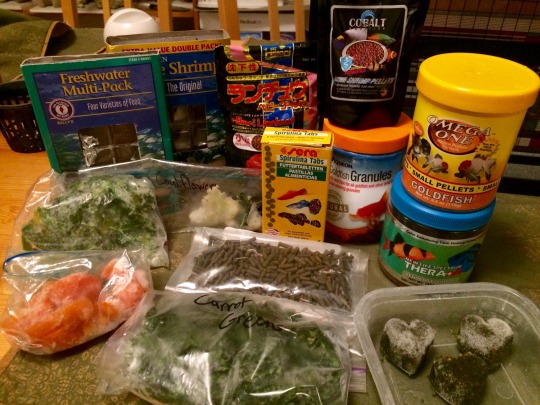#last pic is because fish have mercury in them and eating too much can cause mercury poisoning
Text




If you are FISH I will sjow no RESPECT No MERCY and No REMORSE I will pluck you frome your homes amd use your flesh to feed my family.
#homestuck#dirk strider#little dirk#✦little-dirk#blood#animal death#?#its fish#mine#last pic is because fish have mercury in them and eating too much can cause mercury poisoning#the more you know#he was made through ectobiology with wacky immune systems so hell be fiiiiiiiiine
350 notes
·
View notes
Photo


Thank you so much @headbuttingunicorn :D :D :D
I’m not 100% sure where my little guys originally came from but odds are good it was a feeder tank. The LFS if I’m being optimistic but probably like Petsmart. I rescued them from a bowl after about a week and a half dying in the lobby of my apartment building, they were definitely pretty sorry looking then :/

For the last year and a half or so the three survivors lived in this 50 g

Which technically could have sustained them for most of their lives (I think even by bare minimum standards a 65 would probably be necessary eventually for three fish), but it has weird dimensions (15x36x20″) and honestly?? They were just outgrowing it. They’re over 6 inches now at just a little over two years old. But I’ll talk about their care in here anyway because that’s where they’ve done most of their growing and living the majority of their life.
LOTS of filtration. I've had two Aquaclear 70s on this tank the whole time it’s been up, and for the last 4 months or so, a SunSun HW-304B canister as well. The AC’s are 300 gph (gallons per hour) each, and the SunSun is hOLY SHIT 525 gph oh my god how have I not noticed that.
(Weird story with that one??? I thought I ordered the 265 gph model, found I’d accidentally ordered the 370 gph model, and when the box arrived they had sent me this one which is oh my gooooodddddd 525 wat)
So I had around 600 (and then 1100 whooopps that’s maybe a little too much) total turnover per hour, or about 12x the volume of the tank. With goldfish I always recommend at least 10x, minimum. It really makes such a difference. Even if your water tests come up clear on water change day, the quicker you’re getting the ammonia and nitrite processed out of the water, the less stress the fish’s systems are under in the long run.
They're not expensive either! The Aquaclears are about $45 each online, and the canister is similar. Although sunsun being an Asian company their prices fluctuate a bit.
I have a shit ton of pothos on my tank too, for nitrate munching purposes since my water comes out of the tap already at 10-20 ppm. I.... think it’s going to eat me someday o_O this is it with like four feet of trimming at least.

And even with all that, water changes! I’ll admit I wasn’t always solid on my w/c schedule, my health is iffy at best and running on a 10 day schedule happened fairly often, although I DO NOT recommend that. To make up for it, I almost always do 60-90% changes. Contrary to popular belief, large water changes are not harmful to your fish or your cycle as long as you match the pH and temperature of the fresh water going in. I refill in chunks over the course of an hour or so to avoid shocking them, they pout during the process but as soon as I restart the filters they’re back to normal.
I recently, and I mean recently, as in last week, upgraded to a FRICKIN’ ONE HUNDRED AND FIFTY GALLON TANK??? OMFUCKINGFUCK LOOK

I LOVE IT SO MUCH AND SO DO THEY :D
Holy shit I’ve been fighting with the manufacturers over this thing for wEEKS IT’S FINALLY HERE. 72″x24″x20″ which is such a good shape for goldfish, much better than the standard 150 which is taller and thinner. Ahhh they’re so happy they just go nyoooooom nyooom from one end to the other, and I can add more friends!! Right now I have Remy, Lilac, Ludi, and little Ametrine in there. Plus Sumi in quarantine, but she’s really sick all of a sudden which is why this post took longer than I meant it too, sorry :( I don’t know what happened she just dropsied out of nowhere the other night. She was due to join the others in a week or two, but if she pulls through she’s getting an extended QT now to be sure she’s really healthy
And a skinny lil blind dude I picked up not long ago who may or may not live by himself depending on if I think he can hold his own with the others or not? He’s a spunky cutie but Very Tiny.
Anyway the tank is kind of a mess cause I just chucked every piece of spare decor I have in there to give them something to do, but I have some nice driftwood and just bought a ton of anubias and I’m gonna try actual planted this time!!!
Food food yum yum :) Variety is the spice of life. This pic is from a while ago, I’ve added more to this now probably

I use the Omega One and Thera A as daily staples, rotated with smatterings of the other pellets, as well as Repashy Soilent Green and some of my own homemade gel foods. I really wanna try Northfin pellets too, or AAP Paradigm when I get around to it. I do veggies a few times a week, I’ll buy a bunch of stuff fresh and then blanch and freeze it in baggies to feed over the next couple months. Zucchini, peas, bok choy, cauliflower, kale, spinach, collard greens, broccoli, watercress, etc etc. I usually have four or five at any given time. The frozen proteins I do once every week or two. I’m super allergic to bloodworms so those are a special treat I only feed with gloves :P but they get mysis or brine shrimp usually.
It looks intimidating, but it’s not that difficult. I acquired this stuff bit by bit over the course of a year so you don’t have to go spend a ton of money at once. If I ever just happen to see something that looks fairly good quality for an okay price I’ll grab a small container to try out. Some I end up liking, some I don’t, but even the mediocre stuff I sometimes use as a junk treat, or as snail food. Like I wouldn’t use any of the foods here besides the Repashy, Omega One, Northfin, or NLS as staples. The Aqueon is okay-ish if you have no other option, but the Cobalt is too high in protein for daily feeding, and Hikari has gone so downhill in the last few years. I honestly wouldn’t even buy it, I just feel obligated to use up the bag I already have. Pick maybe two of those staple foods to keep on hand, rotate in veggies a few times a week, some frozen protein here and there and you’re set, don’t absolutely need anything else. Of course more is always better, if you can.
And yes, sigh, dumb as bricks aren’t they? Picky too sometimes. Try a bunch of different vegetables, leafy greens are a good place to start, or zucchini. Boil them soft (you can just chuck it in a glass of conditioned water in the microwave for 2-5 minutes) and cut it into little bite sized pieces. If they don’t go for it right away, keep trying for a couple of days in a row. Eventually they’ll get hungry and warm up to it. Keep your plec occupied with something of his own to eat and feed the goldies at the other end of the tank to try and get them all a bit of something green to eat.
Veggies high in carotenes are really good for enhancing color. So besides your obvious ones like carrot and sweet potato, that’s also going to be your dark leafy greens! If you can get your lil guys onto stuff like collard, spinach, chard, etc, that’ll definitely make a difference in their coloration :)
Gel foods are also a really good option for picky eaters. I’ve never heard of a goldfish that doesn’t like gel, seriously, they adore that shit. You can get premade mixes like Repashy, which you just mix up with some hot water and set in the fridge or freezer. Or you can make your own! Here’s some recipe ideas, or just google “goldfish gel food,” you can scale them waaaaay down if you want. I make pretty small batches that last a long time. And feel free to swap out ingredients too and experiment, or make up your own completely. Just stick to lean, low mercury seafood, and produce without too much sugar and you can mix and match as you please. The one in my freezer right now is mostly watercress and bok choy, a couple spoonfuls of NLS, some cloves of fresh garlic, spirulina, a few baby carrots, a bunch of gross string algae I scooped out of the snail tank, and a dash of paprika. The kids adore it.
Uhhhh let’s see, anything else? I treat with prazi once a year or so, preventative maintenance, like deworming your dog. Besides that I keep medicating to a minimum unless it’s really dire. Minor scrapes and bumps I leave be. Have pretty hard high pH water, usually around 8-8.2. No heater or chiller but the water temp stays low-mid 70s most of the time
I dunno, just plenty of love and attention! I redecorate their tank and make them little toys (try some sturdy nontoxic plastic beads threaded on fishing line, especially if you can find somewhere to wedge food in, enjoy the ensuing adorable) talk to them, draw on the glass...

I love them!!! So much!!!! I owe them my life many times over, that’s not an exaggeration at all. Seeing them in their new tank has really reminded me of how far they’ve come and how much they mean to me. I’m not always a perfect owner and there are times I fall down on their care, but they’re still fat and happy and I’m always trying to do better
23 notes
·
View notes
Text
10 BAD THINGS about Eating MEAT
10 BAD THINGS ABOUT EATING MEAT RELATED BOOK Plant-Based Diet For Dummies By Marni Wasserman There is no doubt that eating meat creates health concerns not only for consumers but also for the environment and (of course) the farmed animals, and it’s unfortunate that people overlook so many of these problems. Animals are taken advantage of, the environment suffers, and ultimately you suffer, as well. MEAT PRODUCTION WASTES NATURAL RESOURCES The world is a diverse place that offers many natural resources. The meat industry places extreme stress on natural resources, causing extreme reduction and depletion: Water Land Food Energy MEAT ISN’T AS RICH IN NUTRIENTS AS PLANTS An animal-based diet isn’t as diverse in terms of nutrients as a plant-based diet is. You pretty much get two main macronutrients — protein and fat — with essentially no vitamins or minerals, and no fiber. What most people don’t know is that the body needs vitamins and minerals to digest and assimilate protein efficiently. Bodies also need fiber to help push things through and assimilate nutrients. Meat intake can build up in the body and slow things down, causing you to feel tired and undernourished. Going plant-based ensures that your body at least gets the nutritional baseline it requires to thrive on a day-to-day basis. ANIMALS ARE FED POOR-QUALITY FEED Most conventionally raised animals are fed bottom-of-the-barrel feed that isn’t in any way natural to them. This not only leaves animals unsatisfied on many levels but also affects their biological makeup. Many are starved of the nutrients they require to be healthy because they’re fed an unnatural diet. This affects not only their well-being but ultimately the well-being of meat consumers. The foods these animals eat aren’t part of their native diet. MEAT IS ACIDIC Meat is one of the major acidic foods in the standard North American diet. It’s difficult for the body to break down and digest and requires extra work from the kidneys. As a result, it produces too much acid in the body. Too much acid not only weakens the body’s immune defenses, which increases risks for infections, but also contributes to chronic diseases. The other consideration to look at is the quality of meat that a majority of people eat: often it’s fried, overcooked, and not eaten alongside green vegetables. This not only creates acidity in the body but also does nothing to help neutralize it. Choosing to eat more plants throughout the day can help balance this ratio. MEAT IS LOADED WITH TOXINS Animals are sponges that soak up toxicity. Because a majority of their biological makeup is fat, their bodies can accumulate an excessive amount of toxins. So, when the animals eat a toxic diet, these toxins get carried with them for life, and they end up in the food you eat. The sea life that swims in polluted oceans and waterways has incredibly absorbent skin and fat, which is why fish and other seafood are often tainted with mercury and other heavy metals. MEAT IS HIGH IN SATURATED FAT It’s one of the things we hear a lot these days: “Be mindful of the amount of saturated fat you eat!” Unfortunately, many people get confused about the sources of this unhealthy fat and don’t realize that a majority of it is from animals. Saturated fat is healthy for the living animal, but the human body can’t break it down in a way that is healthy. Eating the amount of saturated fat from animals that most people do can lead to major health problems. Additionally, many people are eating fried meats, fatty cuts, and skin, with no care for leaner options — all of which contribute to plaque buildup, heart disease, and other diseases, such as obesity and diabetes. EATING MEAT CAN INCREASE YOUR RISK FOR CANCER AND OSTEOPOROSIS In addition to causing heart disease, excess meat consumption leads to other health-degrading conditions, such as osteoporosis and even cancer. The excess protein — despite what people may think — isn’t good for the body. Also, the accumulation of meat can lead to more fatty deposits in the body, which become plaque deposits, and they can start to calcify and affect many of our tissues and bones, causing long-term diseases like heart disease. EATING MEAT IMPACTS CLIMATE CHANGE The impact that meat consumption continues to have on climate change is quite intense. Although most people wouldn’t associate the two, here’s a bit of the picture: To keep up with the demand for meat, cows are fed an incredible amount of food, which produces waste. This waste gives off methane gases, which contribute to ozone depletion by trapping heat in the atmosphere. Manufacturing one calorie from animal protein requires 11 times as much fossil fuel input as producing a calorie from plant protein. Why is this bad? Burning fossil fuels (such as oil and gasoline) releases carbon dioxide, the primary gas responsible for climate change. EATING MEAT IS CRUEL As a result of the increase in demand for meat, factory farms (large, industrialized farms on which large numbers of livestock are raised indoors in conditions intended to maximize production at minimal cost) are on the rise. Very little care is taken for the animals’ welfare. They’re given antibiotics to combat the infections they get from living in such close quarters and growth hormones to increase their size and weight in an unnaturally short period of time (and both of these things eventually wind up in your food). THE MEAT INDUSTRY IS GETTING WORSE The more control mankind has had over food, the worse it has gotten. This is apparent with packaged foods but especially with animal-based foods. Obviously, an increased demand for meat has strained the supply chain. To put enough meat on the shelves at inexpensive prices, farmers have put into place often-unsustainable practices. This can mean manipulating the environments in which animals are raised, which can lead to contamination of the animal feed, the soil, the land, and ultimately the meat on your plate. It’s no wonder that every couple of years you hear about some bacteria, such as salmonella or E. coli, that has found its way into the food supply. PROMOTED STORIES FROM AROUND THE WEB Ellen’s Crazy Transformation – You’ll Never Believe This! www.popnewsdeluxe.com The key drivers behind crude oil prices Viva Energy Their Last Moments: Powerful Images Snapped Before Tragedy Struck (Pics) Click Popping You will not want to switch off your computer. Build your city! Elvenar Arming Yourself with Knowledge Before Refinancing Your Home realestate.com.au How to wake every morning with luminous skin She is, Sarah Jane These Rarely Seen Historical Photos are Pretty Unnerving Starfluff After Seeing These Photos You Will Believe In Time Travel Mozo Travel Recommended by FOOD & DRINKSPECIAL DIETSPLANT BASED DIETPLANT-BASED DIET FOR DUMMIES PLANT-BASED DIET FOR DUMMIES Plant-Based Diet For Dummies MORE ABOUT THIS BOOK Author: Marni Wasserman
3 notes
·
View notes